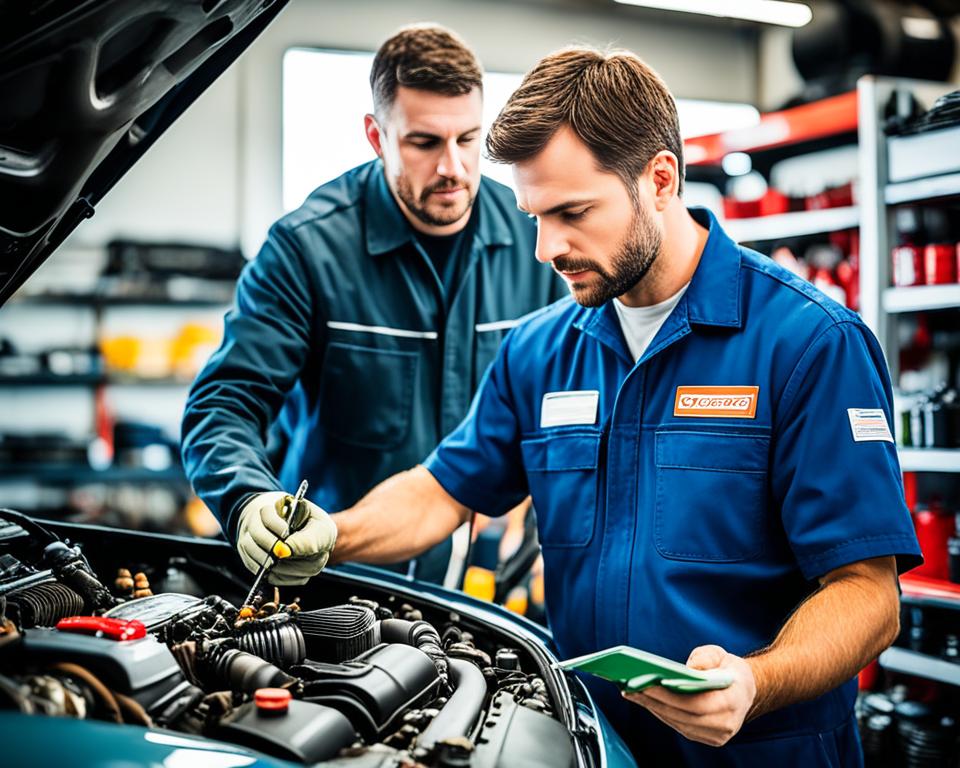Maintaining the pristine appearance of your car involves more than just regular washing. In this section, I’ll share advanced car maintenance insights that will help you keep your vehicle in top shape. From car waxing to paint protection and brake maintenance, I’ll cover a range of topics that will elevate your car care routine and ensure your automobile stays in pristine condition.
Key Takeaways:
- Regular car maintenance goes beyond washing to ensure your vehicle stays in top shape.
- Car waxing and paint protection can help maintain the appearance and longevity of your vehicle’s paint finish.
- Brake maintenance is essential for safety and performance.
- Winterization is crucial to protect your car during cold weather conditions.
- Hybrid vehicles have unique maintenance requirements to maintain their eco-friendly performance.
The Essential Role of Regular Car Waxing
Regular car waxing is a crucial step in maintaining the appearance and protecting the paint finish of your vehicle. By applying wax to your car’s exterior, you create a protective barrier that shields the paint from various damaging factors, such as UV rays, dirt, and pollutants.
Car wax not only adds a beautiful shine to your vehicle but also acts as a sacrificial layer, absorbing small scratches and preventing them from reaching the underlying paint. This helps to maintain the pristine condition of your car’s exterior for longer periods.
Benefits of Protecting Paint Finish with Wax
Protecting the paint finish of your car with wax offers numerous benefits:
- Enhanced shine: Car wax gives your vehicle a glossy, showroom-like appearance, making it stand out on the road.
- UV protection: Wax acts as a barrier against the harmful effects of UV rays, helping to prevent fading and oxidation of the paint.
- Paint preservation: By creating a protective layer, wax helps to preserve the original paint color and prevent premature wear and tear.
- Easy cleaning: A waxed surface repels dirt and grime, making it easier to clean your car and maintain its overall cleanliness.
Establishing the Optimal Waxing Routine
To maximize the benefits of car waxing and ensure optimal protection for your vehicle’s paint finish, it’s essential to establish a regular waxing routine. Here are some key considerations:
- Frequency: Depending on factors such as climate, driving conditions, and exposure to environmental elements, waxing your car every three to four months is generally recommended. However, if your vehicle is frequently exposed to harsh elements or if the wax protection starts to diminish, more frequent waxing may be necessary.
- Clean the surface: Before applying wax, it’s important to thoroughly clean and dry your car’s exterior to remove any dirt, debris, or previous wax residue. This ensures that the wax can adhere properly and provide effective protection.
- Choose the right wax: There are various types of car wax available, such as paste wax, liquid wax, and spray wax. Consider your preferences and the specific needs of your vehicle when selecting the wax that best suits your requirements.
- Apply the wax: Follow the instructions provided with the wax product to apply it evenly and thinly across your car’s surface. Use a soft cloth or foam applicator pad, working in small sections. Allow the wax to dry to a haze before buffing it off with a clean microfiber cloth, revealing a brilliant shine.
By incorporating regular car waxing into your vehicle maintenance routine and following these tips, you can ensure that your car’s paint finish remains protected, vibrant, and lustrous.
Advancements in Paint Protection: PPF and Ceramic Coatings
Advancements in paint protection technology have revolutionized the way we can safeguard our vehicles’ pristine appearance. Two popular options in the market are Paint Protection Film (PPF) and ceramic coatings. In this section, we’ll explore these advancements and their benefits in detail, helping you make an informed decision about which option is best for your vehicle.
Paint Protection Film (PPF)
PPF is a transparent, thermoplastic urethane film that is applied to the painted surfaces of your vehicle. It acts as a protective shield, offering high resistance to scratches, stone chips, and other minor abrasions. PPF provides excellent protection for your vehicle’s paint, preserving its showroom finish for years.
Ceramic Coatings
Ceramic coatings, or nano-coatings, are liquid polymer coatings that chemically bond to the paint surface of your vehicle. When applied correctly, ceramic coatings create a protective layer that enhances the paint’s resistance to UV rays, chemicals, bird droppings, and other environmental contaminants. Not only do ceramic coatings provide exceptional protection, but they also impart a glossy and hydrophobic finish, making your vehicle easier to clean.
Both PPF and ceramic coatings offer significant advantages when it comes to paint protection. However, there are certain differences that you should consider in order to choose the most suitable option for your specific needs. Here’s a quick comparison:
| Paint Protection Film (PPF) | Ceramic Coatings | |
|---|---|---|
| Protection | Effectively protects against scratches, stone chips, and minor abrasions | Enhances resistance to UV rays, chemicals, and environmental contaminants |
| Appearance | Offers a virtually invisible layer of protection | Imparts a glossy and hydrophobic finish |
| Durability | Durable and can last for several years | Requires periodic reapplication for optimal performance |
| Application | Requires professional installation for seamless results | Can be applied by professionals or experienced DIYers |
As you can see, both options provide excellent protection, so it ultimately comes down to your personal preference and budget. Some vehicle owners choose to combine PPF and ceramic coatings for maximum protection, with PPF applied to the high-impact areas and ceramic coatings used as an overall layer of defense.
By investing in paint protection solutions like PPF and ceramic coatings, you can shield your vehicle’s paint from the harsh elements and maintain its flawless appearance for years to come. Consult with a professional detailing service to determine the best option that suits your specific needs and enjoy the added peace of mind they bring.
Determining the Right Brake Pads for Your Vehicle
When it comes to ensuring the safety and performance of your vehicle, brake maintenance is crucial. One key aspect of brake maintenance is selecting the right brake pads for your vehicle. The type of brake pads you choose can have a significant impact on your car’s braking performance, durability, and even noise levels.
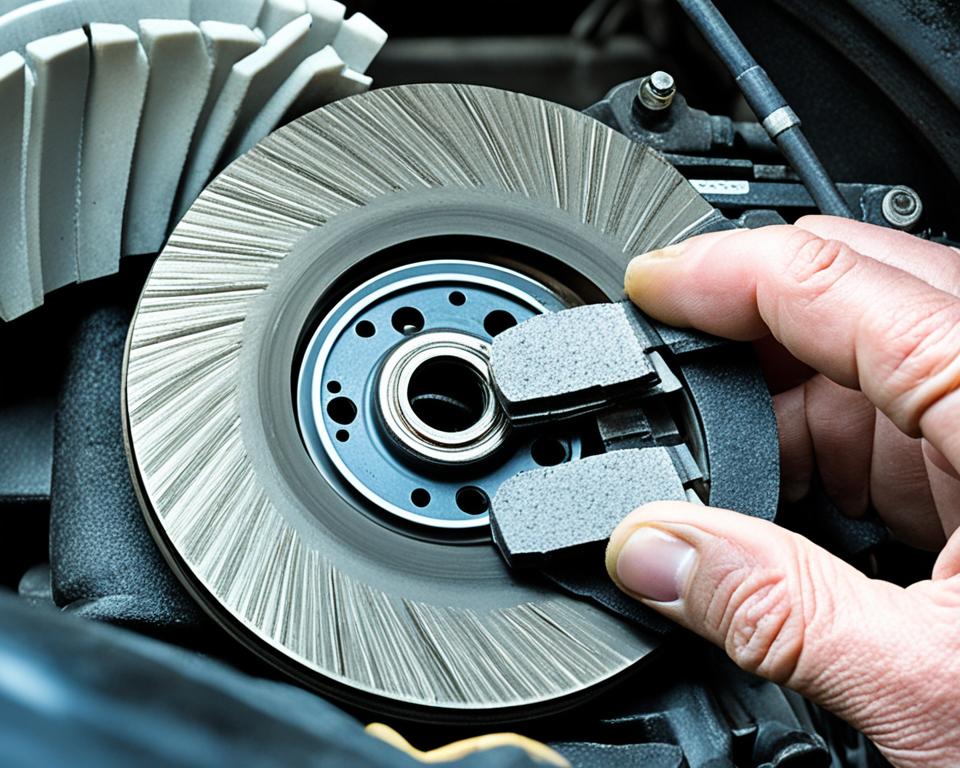
To help you make an informed decision, let’s compare two popular types of brake pads: ceramic and semi-metallic.
Ceramic vs Semi-Metallic: A Comparative Analysis
Ceramic Brake Pads:
- Made from a dense ceramic compound
- Provides excellent stopping power
- Generates less dust compared to semi-metallic pads, keeping your wheels cleaner
- Generally quieter during braking
- Offers better heat dissipation, reducing the risk of brake fade
- Gentler on rotors, leading to increased rotor life
Semi-Metallic Brake Pads:
- Composed of metal fibers mixed with other materials
- Offers good overall performance and durability
- Can handle high temperatures without sacrificing braking power
- Provides excellent stopping power, especially in heavy-duty applications
- Tends to be more affordable compared to ceramic pads
- May generate more dust and create more noise during braking compared to ceramic pads
Ultimately, the choice between ceramic and semi-metallic brake pads depends on your specific needs and preferences. Consider factors such as your driving style, vehicle type, and budget when deciding which type of brake pads to install.
Enhancing Safety through Adequate Brake Maintenance
Regardless of the type of brake pads you choose, proper brake maintenance is essential for optimal safety and performance. Here are some key brake maintenance tips to keep in mind:
- Regularly inspect brake pads for wear and replace them when necessary.
- Check the brake fluid level and top it up if needed.
- Have your brake system checked by a qualified technician at recommended intervals.
- Listen for any unusual noises or vibrations when braking and address them promptly.
- Follow the manufacturer’s guidelines for brake pad break-in to ensure proper bedding and optimal performance.
By prioritizing brake maintenance and choosing the right brake pads for your vehicle, you can enhance safety, prolong the lifespan of your braking system, and enjoy a smoother driving experience.
Preventive Car Maintenance: Winterization Essentials for Your Vehicle
As the winter season approaches, it’s important to take proactive measures to ensure your vehicle is prepared to handle the cold weather conditions. Winterization is a crucial aspect of preventive car maintenance, and it involves a series of essential steps to maintain your car’s performance and safety during the winter months.
Here are some winterization essentials and vehicle care tips for winter:
- Prepare your car for cold weather by checking the following:
- Ensure your battery is in good condition and fully charged. Cold weather can put a strain on the battery, so it’s essential to have it tested and replaced if necessary.
- Inspect your tires for tread wear and proper inflation. Consider switching to winter or all-season tires for better traction on snowy or icy roads.
- Check your antifreeze levels and ensure the coolant mixture is appropriate for the winter temperatures. This will prevent your engine from freezing or overheating.
- Inspect your brakes to ensure they are in good working condition. Cold weather can affect brake performance, so it’s crucial to address any issues before winter sets in.
- Check your windshield wipers and replace them if necessary. It’s important to have clear visibility during snow or rain showers.
- Ensure your vehicle’s heating system is functioning properly. Being able to defrost your windshield and stay warm inside the car is essential for your comfort and safety.
- Stock up on essential items for emergencies, such as a flashlight, ice scraper, jumper cables, and a blanket.
- Keep a bag of sand, kitty litter, or traction mats in your trunk to provide extra traction if your vehicle gets stuck in snow or ice.
- Drive cautiously and maintain a safe distance from other vehicles. Winter conditions can make roads slippery, so it’s important to adjust your driving accordingly.
By following these preventive car maintenance tips and winterization essentials, you can ensure your vehicle remains reliable and ready to tackle the cold. Taking the time to prepare your car for winter will not only enhance its performance and safety, but also give you peace of mind during the chilly months ahead.
Hybrid Car Care: Specialized Maintenance for Eco-Friendly Vehicles
Hybrid vehicles offer a greener alternative to traditional gasoline cars, but they require specialized maintenance to ensure their eco-friendly performance and longevity. In this section, we’ll delve into the nuances of hybrid car care, including understanding hybrid battery health and longevity, as well as periodic servicing checks unique to hybrid systems.
Understanding Hybrid Battery Health and Longevity
The hybrid battery is a crucial component of a hybrid vehicle, powering the electric motor and providing energy efficiency. To maintain optimal performance and extend the battery’s lifespan, it’s essential to understand hyrid battery health.
The hybrid battery features advanced technology that requires periodic inspections to evaluate its condition. Regular checks can help identify any potential issues and ensure the battery’s efficiency is maintained. By monitoring the hybrid battery’s health, you can enjoy uninterrupted eco-friendly driving and avoid unexpected battery failure.
“Regular inspections and monitoring of the hybrid battery’s health are crucial for maintaining the performance of your hybrid vehicle and prolonging the life of the battery.”
Furthermore, proper charging habits and avoiding prolonged exposure to extreme temperatures can help optimize the battery’s overall health and longevity. It’s important to follow the manufacturer’s guidelines and recommendations regarding hybrid battery care, ensuring you get the most out of your hybrid vehicle.
Periodic Servicing Checks Unique to Hybrid Systems
In addition to battery health, hybrid vehicles also require periodic servicing checks that are unique to their hybrid systems. These specialized checks go beyond the routine maintenance required for conventional vehicles.
During periodic servicing, hybrid system diagnostics, such as checking the inverter, power distribution, and auxiliary systems, are performed to ensure optimal performance and prevent any potential issues. These checks help identify any abnormalities or malfunctions specific to the hybrid system.
In some cases, specialized equipment and tools may be required for these servicing checks. It’s crucial to have periodic servicing performed by certified technicians with expertise in hybrid systems to ensure accurate diagnosis and maintenance.
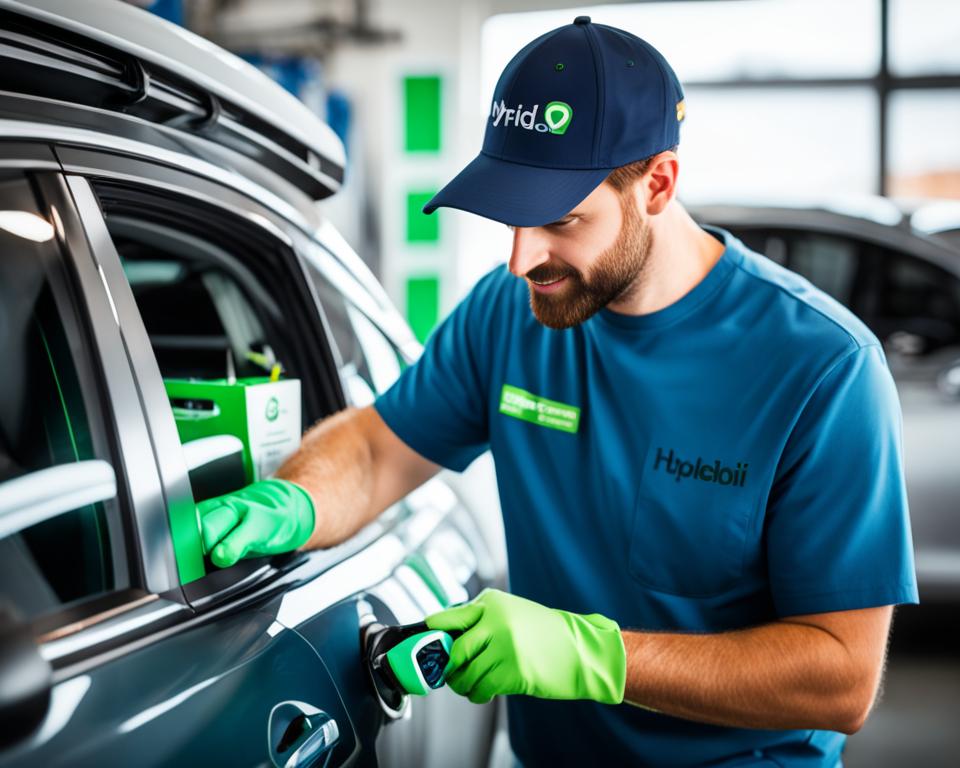
By prioritizing hybrid car care and addressing specific maintenance needs, you can maximize the efficiency, reliability, and environmental benefits of your hybrid vehicle. Regular inspections and periodic servicing checks will help you enjoy the advantages of hybrid technology while ensuring your vehicle remains in top condition.
Car Maintenance Tips: Steering Your Way to a Smoother Drive
The steering system plays a crucial role in the smooth operation of your vehicle. To ensure a smoother and safer driving experience, it is important to have proper steering system maintenance. Here are some essential car maintenance tips for steering systems:
- Check and maintain power steering fluid: Regularly check the power steering fluid level and top it up if necessary. Low power steering fluid levels can result in difficulty in steering and potentially damage the steering mechanism.
- Inspect steering components: Periodically inspect the steering components like tie rods, ball joints, and steering linkage for any signs of wear and tear. Replace any damaged or worn-out parts to maintain optimal steering performance.
- Address common steering issues: Keep an eye out for common steering issues like uneven steering, excessive play in the steering wheel, or difficulty in turning. If you experience any of these issues, have your steering system thoroughly inspected and repaired by a professional.
By following these car maintenance tips for steering systems, you can ensure a smoother and safer driving experience. Regular checks and maintenance of the power steering fluid and steering components will help maintain the integrity of your vehicle’s steering system, resulting in a smoother drive.
Handling Volvos: Common Issues and Maintenance Strategies
When it comes to owning a Volvo, you can expect a vehicle that prioritizes safety and reliability. However, every car has its quirks and unique maintenance needs. In this section, I will explore some of the common issues faced by Volvo owners and provide maintenance strategies to keep your Volvo in top condition. Additionally, I will discuss the modern Volvo quirks that you should be aware of and share essential tips for monitoring your Volvo’s health.
Modern Volvo Quirks and How to Tackle Them
While Volvo cars are renowned for their performance and advanced technology, they do come with their own set of quirks. Understanding these quirks can help you identify and address potential issues effectively. Here are a few modern Volvo quirks you should know about:
- Electrical System Glitches: Some Volvo models may experience occasional glitches in the electrical system, such as faulty sensors or intermittent dashboard lights. To tackle these issues, it is essential to stay up to date with software updates and regularly inspect the electrical components.
- Transmission Problems: Certain Volvo models may encounter transmission issues, such as rough shifting or gear slipping. Regularly checking the transmission fluid levels and getting timely maintenance can help prevent major problems and ensure a smooth driving experience.
- Suspension Noise: Volvos are known for their comfortable rides, but some models may develop suspension noises over time. Proper maintenance, including inspecting suspension components and replacing worn-out parts, can help address these noises and maintain a smooth ride.
By understanding these quirks and staying proactive in your Volvo’s maintenance, you can ensure a reliable and enjoyable driving experience.
Keeping an Eye on Your Volvo’s Health: Essential Tips
Regular maintenance and diligent monitoring are key factors in keeping your Volvo in optimal condition. Here are some essential tips to help you maintain your Volvo’s health:
- Follow the Manufacturer’s Maintenance Schedule: Stick to the recommended maintenance intervals provided by Volvo. This includes regular oil changes, filter replacements, and inspections of critical components such as brakes, tires, and the cooling system.
- Pay Attention to Warning Lights: Volvo vehicles are equipped with sophisticated onboard diagnostic systems that can alert you to potential issues. When a warning light appears on the dashboard, take it seriously and have your Volvo inspected by a certified technician.
- Address Common Volvo Issues Promptly: Familiarize yourself with common Volvo issues, such as oil leaks, failing ignition coils, or worn-out suspension components. If you notice any signs of these issues, address them promptly to prevent further damage and potential safety risks.
By following these essential tips and being proactive in your Volvo’s maintenance, you can extend its lifespan, maintain its performance, and enjoy a worry-free ownership experience.
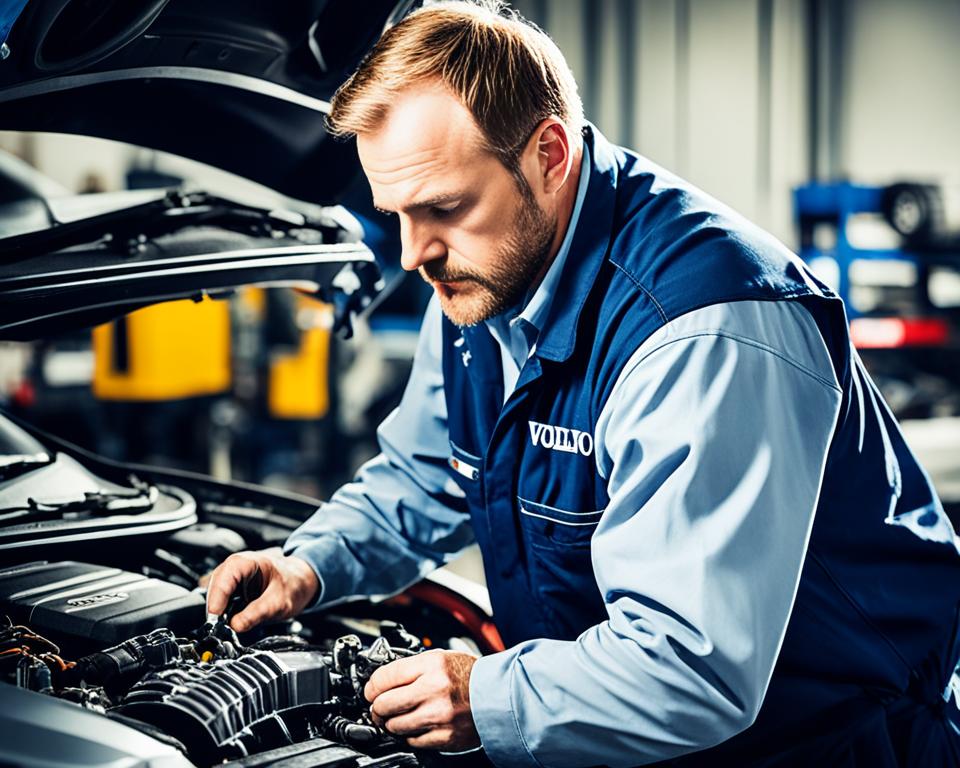
Seasonal Considerations for Vehicle Maintenance: How to Shield Your Car in Seattle’s Summer
When it comes to maintaining your vehicle’s performance and appearance, seasonal considerations play a crucial role. In the summer months, Seattle experiences unique challenges that can impact your car’s condition. To ensure your vehicle stays in top shape during the summer, it’s important to prioritize car care in summer and implement the right maintenance strategies specific to the Seattle climate. By shielding your car from the summer heat, protecting the paint from UV rays, and addressing other seasonal challenges, you can keep your vehicle looking and running its best.
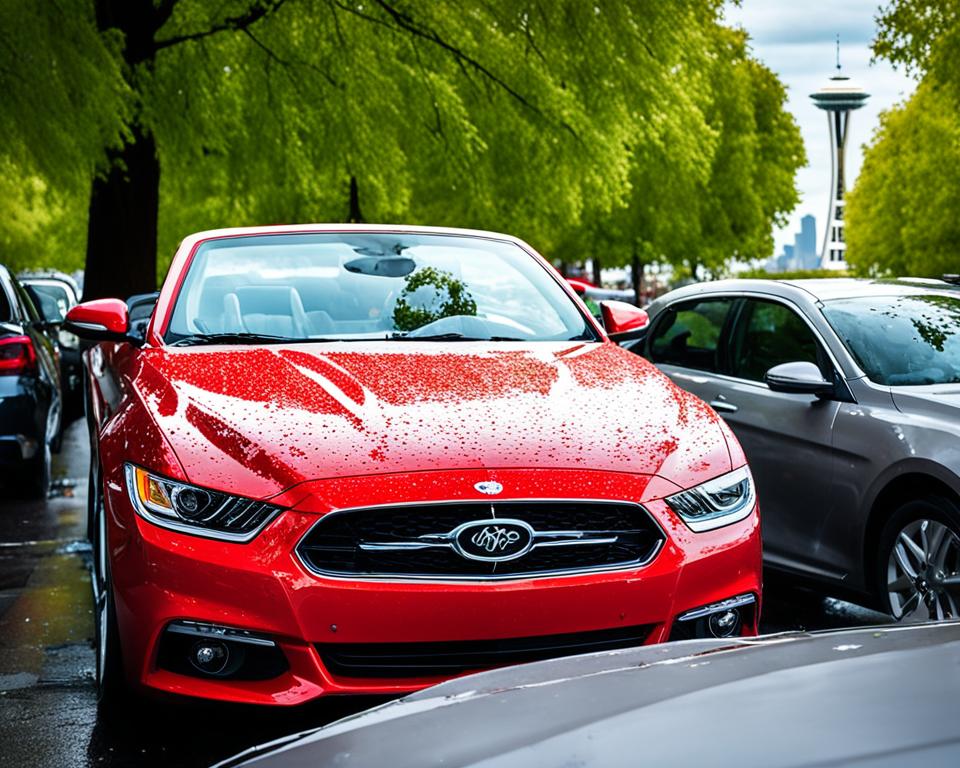
The scorching summer heat in Seattle can take a toll on your car. By implementing seasonal vehicle maintenance and following these car care tips in summer, you can protect your investment and maintain your car’s performance and appearance throughout the season.
Here are some valuable tips and insights for effectively maintaining your car in Seattle’s summer:
- Shielding your car from the summer heat: Park your car in shaded areas whenever possible to minimize exposure to direct sunlight. Consider using sunshades or window visors to keep the interior cool and protect the dashboard from fading. Additionally, applying a layer of quality car wax can provide an extra barrier against the sun’s rays and prevent paint damage.
- Protecting the paint from UV rays: Seattle’s summer sun can be intense, leading to paint oxidation and fading. Regularly wash your car and apply a UV-resistant car wax to protect the paint from sun damage. If feasible, consider parking your vehicle in a covered area to further shield it from UV rays.
- Addressing other seasonal challenges: Seattle’s summer may bring occasional rain showers. It’s important to maintain the integrity of your car’s wipers and replace them if necessary. Additionally, check your tire pressure regularly, as fluctuations in temperature can affect tire performance. Adequate tire maintenance ensures optimal grip and handling on wet roads.
By following these tips and implementing Seattle summer car maintenance, you can keep your vehicle protected and ensure its longevity, even in the challenging summer conditions. Taking proactive measures now will save you from potential issues later and allow you to enjoy a smooth and worry-free driving experience throughout the summer.
| Importance of Car Maintenance in Seattle’s Summer | Car Care Tips for Summer |
|---|---|
| 1. Protects the paint from UV rays | 1. Park in shaded areas |
| 2. Prevents paint oxidation and fading | 2. Use sunshades or window visors |
| 3. Ensures optimal grip on wet roads | 3. Regularly wash and apply UV-resistant car wax |
| 4. Preserves interior components | 4. Check and replace wipers as needed |
| 5. Improves overall performance and longevity | 5. Monitor tire pressure and maintain tires |
Conclusion
In conclusion, incorporating advanced car maintenance insights into your routine is crucial for keeping your vehicle in top shape. By following tips and strategies such as regular car waxing, brake maintenance, winterization essentials, and hybrid car care, you can enhance the longevity, performance, and appearance of your automobile.
Regular car waxing helps protect the paint finish, ensuring it stays glossy and free from damage caused by environmental elements. Establishing an optimal waxing routine will preserve your car’s shine and ensure it retains its pristine appearance.
Additionally, taking care of your vehicle’s brake system is vital for safety and performance. Selecting the right brake pads and performing regular maintenance checks will ensure optimal braking efficiency and avoid potential issues.
Seasonal considerations, such as summer car maintenance in Seattle, are also important. Shielding your car from the summer heat, protecting the paint from UV rays, and addressing other seasonal challenges will help maintain your vehicle’s performance and appearance.
By implementing these insights and strategies into your car care routine, you can enjoy the benefits of a well-maintained automobile that retains its value and reliability for years to come.
